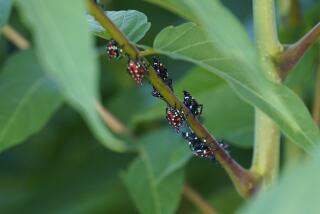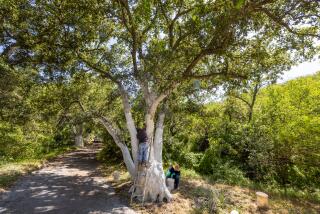Their summer flights of fancy
No creature matches the comic aplomb of the June beetle. Any day now, it will appear in our gardens, its flight so unsteady that it will make a bumblebee look like a Harrier jet. Yet somehow it will be aloft. Then, bap! It will head straight into a fence and tumble to the ground. As we debate whether to deliver the coup de grâce, it will collect itself, take flight and proceed with doughty conviction in the general direction of a fig tree.
The June beetle is such an unlikely flier, so aerodynamically incorrect, that it seems like a mirage — sunstroke with a sense of humor. In fact, it is the quirkiest harbinger of summer, the cue to look to our orchards. When June beetles arrive, the fruit is ripe.
Peach lovers among us can put down the slingshots. According to entomologist Arthur V. Evans, June beetles are harmless. “They go for fruit that’s already been damaged,” says Evans, co-author of a nice 2004 book, “Introduction to California Beetles.”
If the name June beetle doesn’t ring a bell, this bug has plenty of aliases. Fig eater. Peach beetle. Texas beetle. To Evans, the safest term is the scientific one, Cotinis mutabilis, a noun-adjective combo that states the genus, then describes the species. The genus name comes from the Greek kotinos, for “wild olive,” and probably refers to the beetle’s green coloring, thinks Evans. The species name, mutabilis, translates as “changeable,” a reference to its metamorphosis from grub to beetle.
As for the suggestion that the beetle is olive-colored, maybe in Oz. Anyone know the Greek for Glam Rock Bug? The iridescent green and the gold trim (never mind the fold-out wings) seem more like something out of a 1974 Roxy Music tour. Yet according to John Abbott, an entomologist at the University of Texas, our June beetles are nothing special, especially in the tropics. “There are tens of thousands of beetles that are just eye-popping,” he says.
What our beetle lacks in beauty, it compensates with panache. It’s a western bug that hails from Arizona. On the wing, it has only two objects of desire: sex and fruit juice. Only a little juice will suffice — say, dribbles of sap oozing from mesquite and prickly pear.
As for the sex, the hope that the bug’s bright green armor might be the beetle equivalent of peacock coloration — a device to attract mates — didn’t find much support. Evans, Abbott, Michael Caterino of the California Beetle Project at the Santa Barbara Museum of Natural History and Jim Melli at the San Diego Natural History Museum all came back with the answer: Sorry, no. The coloration is more likely camouflage, they guessed, which might have evolved to thwart birds of prey in shimmering sun.
Then do they sing for seduction, click even?
“No, no song, either” says Evans. “June beetles find each other by pheromones. They don’t undergo any type of elaborate courtship.”
So much for romance.
After mating, the males die earlier than the females, who have more work to do, namely looking for a place to lay fertilized eggs. They need rotting organic matter, preferably enough to protect the eggs as they hatch into larvae, and they need to feed the larvae, or grubs.
June beetles spend winter as grubs, where they fatten so handsomely on rotting leaves and decomposing wood, they twice lose their skin. “Fear Factor” uses them to nauseate its audience, but in the wild, June beetle larvae are nothing short of a delicacy. Ask any raccoon, fowl or back--to-nature type. Lawn care companies say they damage turf and exhort us to kill them using pesticidal soil drenches. Wrong beetle, says Melli.
June beetle grubs in compost are usually curled in a protective C-shape. Their fans can tell you how they undulate through rotting vegetable matter. They squirm along on their backs, say the beetle fanciers.
Cool.
Then comes the pupal stage, when the beetle forms its bright green shell. For the butterfly, this takes place in a cocoon. The June beetle must metamorphose underground, so its larva forms a pupal chamber from its own frass — in plainer English, grub poop. Evans is convincing when he says: “This deters predators.”
The mature beetles emerge just as fruit ripens. A really good mother will have laid eggs near a prickly pear cactus, so the fledgling can go straight to the juice bar. As it emerges from its lair, the plating might seem clunky, but the armor is actually a study in economy. Its skin is its skeleton, or exoskeleton. This tough, waxy material helps conserve water and makes them less appetizing to birds and lizards. It also lessens the impact of midair collisions. “It’s really strong, so when they hit something, they don’t splatter,” says Melli.
Melli used to love them as a kid, even tried tying notes to them to see if they could still fly. “They don’t stink or bite,” he says. “They have really powerful, pretty sharp little claws and a shovel-like structure on their head, a little scoop to enter the fruit. When you hold them, they push it against your hand. It might startle you, and you might think, ‘It’s gonna hurt me,’ but they never do. They’re harmless.”
How many times they can bump into fences and recover isn’t clear. None of the beetle experts were too sure how long they live. “Weeks?” guesses Evans. “Months in a terrarium,” says Melli, adding that they like moistened figs, a nice bedding of earth and some organic matter.
However long they manage in the wild, their trip out of Arizona is a clue to the bumbling beetle’s stamina. Somehow they caught wind of the fruit imported by the Spanish. A whiff of juice dripping from a split orange was enough to bring them out of the desert to Southern California, from where June beetles followed missionaries and their orchards north through the Central Valley.
If only the fates of other native bugs were so happy. The June beetle came out of the Old West and settled in the new suburban one with equanimity. No, better than that: usefulness. As the larvae spend winter chewing through our compost heaps, they’re breaking down autumn leaves into spring soil.
Not long after they arrive, and we become used to their precarious navigation, they disappear. It is a wistful day when a gardener comes across the first shattered piece of green armor. There goes another generation of June beetles. “Yeah,” says Evans. “But your compost heap will be seething with them.”
Emily Green can be reached at emily.green@latimes.com
*(BEGIN TEXT OF INFOBOX)
More on a bug’s life
The June beetle is hardly a pest. Its larvae spend winter turning autumn leaves into spring soil. To learn more:
Recommended reading: “Introduction to California Beetles” by Arthur V. Evans and James N. Hogue, University of California Press, 2004. “Insects of the Los Angeles Basin” by Charles L. Hogue, Natural History Museum of Los Angeles County, 1994.
Summer outing: “Backyard Monsters,” exhibit through Jan. 1 at the San Diego Natural History Museum, 1788 El Prado, Balboa Park; (619) 232-3821.
California Beetle Project: Contact the Santa Barbara Museum of Natural History, 2559 Puesta del Sol Road, (805) 682-4711; or go to www.sbnature.org/collections/invert/entom/cbphomepage.php.
More to Read
Sign up for The Wild
We’ll help you find the best places to hike, bike and run, as well as the perfect silent spots for meditation and yoga.
You may occasionally receive promotional content from the Los Angeles Times.










